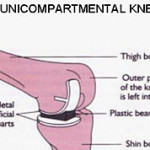A total knee replacement is a surgical procedure whereby the diseased knee joint is replaced with artificial material. The knee is a hinge joint which provides motion at the point where the thigh meets the lower leg. The thigh bone (or femur) abuts the large bone of the lower leg (tibia) at the knee joint. During a total knee replacement, the end of the femur bone is removed and replaced with a metal shell. The end of the lower leg bone (tibia) is also removed and replaced with a channeled plastic piece with a metal stem. Depending on the condition of the kneecap portion of the knee joint, a plastic “button” may also be added under the kneecap surface.
The posterior cruciate ligament is a tissue that normally stabilizes each side of the knee joint so that the lower leg cannot slide backward in relation to the thigh bone. In total knee replacement surgery, this ligament is either retained, sacrificed, or substituted by a polyethylene post. Each of these various designs of total knee replacement has its benefits and risks.
What patients should consider a total knee replacement?
Total knee replacement surgery is considered for patients whose knee joints have been damaged by either progressive arthritis, trauma, or other rare destructive diseases of the joint. The most common reason for knee replacement in the United States is severe osteoarthritis of the knees.
What are the risks of undergoing a total knee replacement?
Risks of total knee replacement include blood clots in the legs that can travel to the lungs (pulmonary embolism). Pulmonary embolism can cause shortness of breath, chest pain, and even shock. Other risks include urinary tract infection, nausea and vomiting (usually related to pain medication), chronic knee pain and stiffness, bleeding into the knee joint, nerve damage, blood vessel injury, and infection of the knee which can require re-operation. Furthermore, the risks of anesthesia include potential heart, lung, kidney, and liver damage.
What is involved with the preoperative evaluation for total knee replacement?
Before surgery, joints adjacent to the diseased knee are carefully evaluated. This is important to ensure optimal outcome from the surgery. Replacing a knee joint which is adjacent to a severely damaged joint may not yield significant improvement in function.
Routine blood tests of liver and kidney function, and urine tests are evaluated for signs of anemia, infection or abnormal metabolism. Chest x-ray and EKG are performed to exclude significant heart and lung disease which may preclude surgery or anesthesia. Finally, it is less likely to have good long-term outcome if the patient’s weight is greater than 200 pounds. Excess body weight simply puts the replaced knee at an increased risk of loosening and/or dislocation.
A similar risk is encountered in younger patients who may tend to be more active, thereby adding trauma to the replaced joint.
What happens in the postoperative period?
A total knee replacement generally requires between one and one- half to three hours of operative time. After surgery, patients are taken to a recovery room, where vital organs are frequently monitored. When stabilized, patients are returned to their hospital room.
Physical therapy is an extremely important part of rehabilitation and requires full participation by the patient for optimal outcome. Patients can begin physical therapy forty-eight hours after surgery. Some degree of pain, discomfort, and stiffness can be expected during the early days of physical therapy. Knee immobilizers are used in order to stabilize the knee while undergoing physical therapy, walking, and sleeping. They may be removed under the guidance of the therapist for various portions of physical therapy.
A unique device that can help speed recovery is the continuous passive motion (CPM) machine. The CPM machine is first attached to the operated leg. The machine then constantly moves the knee through various degrees of range of motion for hours while the patient relaxes.
Patients will start walking using a walker and crutches. Eventually, patients will learn to walk up and down stairs and grades. A number of home exercises are given to strengthen thigh and calf muscles.
How does the patient continue to improve as an outpatient after discharge from the hospital?
It is important for patients to continue in an outpatient physical therapy program along with home exercises for optimal outcome of total knee replacement surgery. Patients will be asked to continue exercising the muscles around the replaced joint to prevent scarring (contracture) and maintain to muscle strength for the purposes of joint stability.
The wound will be monitored by the attending physicians and their staff for healing. Patients also should watch for warning signs of infection including abnormal redness, increasing warmth, swelling, or unusual pain. It is important to report any injury to the joint to the doctor immediately.
Future activities are generally limited to those that do not risk injuring the replaced joint. Sports that involve running or contact are avoided, in favor of leisure sports, such as golf, and swimming. Swimming is the ideal form of exercise, since the sport improves muscle strength and endurance without exerting any pressure or stress on the replaced joint.
Though infrequent, patients with total knee replacements can require a second operation years later. The second operation can be necessary because of loosening, fracture or other complications of the replaced joint. Re-operations are generally not as successful as the original operation and carry higher risks of complications. Future replacement devices and techniques will improve patient outcomes and lead to fewer complications.







